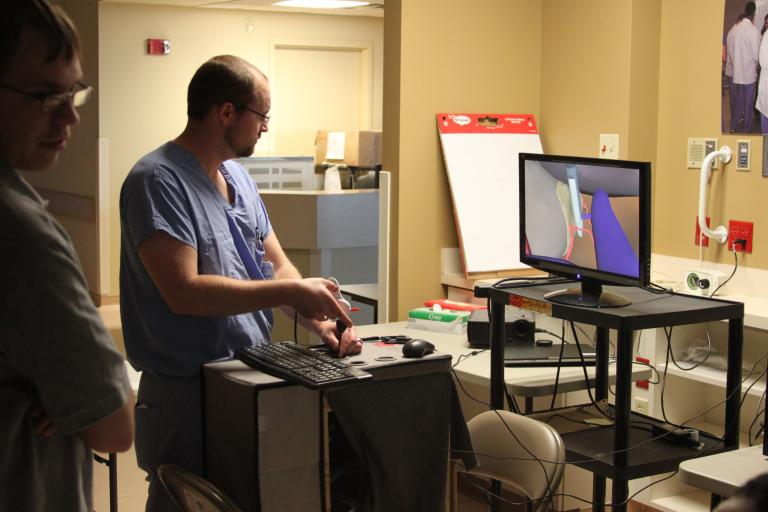
“It definitely lets you feel the pressure applied during the procedure. As the software and training develop, it will be something very beneficial for the surgery world.”
Work being done in Kettering University’s Research in Engineering and Collaborative Haptics (REACH) Lab, along with a thriving local medical community, have created many opportunities for Kettering students studying Haptics to use the technology to help solve real-world medical issues.
Haptics technology allows a user to ‘touch’ virtual objects by using forces, vibrations or movements of the user in simulations. It has a wide variety of practical uses in various industries, but students in the REACH lab have found the technology particularly useful in coming up with practical applications of haptics in the local medical community.
A group of students has been working with Genesys Regional Medical Center for more than six months on a haptic-enabled device that simulates the laparoscopic adrenalectomy, or removal of the adrenal gland, procedure. The surgery is minimally invasive with laparoscopic instruments, but officials at Genesys have shown an interest in adding a haptic element to their surgical tools. The system Kettering students have worked on would give surgeons a ‘pressure point’ and force feedback in addition to the visual feedback they have on a screen. This would allow surgeons to feel how much pressure they are using with the surgical instrument.
“The idea and the concept is very innovative,” said Sara Wasilenko, a third-year general surgery resident at Genesys who has tested the device being created by Kettering students. “It definitely lets you feel the pressure applied during the procedure. As the software and training develop, it will be something very beneficial for the surgery world.”
Students working on the haptic simulator have visited Genesys several times to let doctors and residents test it.
“We’ve provided a simulation to residents and doctors so they can test it and give us feedback,” said Reza Yousefian, a Kettering graduate student in Electrical and Computer Engineering. “They try the simulation with and without haptic feedback and let us know their opinions. We want to test their accuracy and record the data from them during the test.”
Yousefian is among several students working on the project. He has an undergraduate degree in Electrical Engineering and became interested in biomedical applications and Haptics once he arrived at Kettering.
“I have a background in electrical engineering and I love to work in multidisciplinary area,” Yousefian said. “Haptics is a really cool technology, especially related to the medical industry. You can use Haptics to make a difference.”
Kettering has also been involved in a project with McLaren Regional Medical Center to develop a new laparoscopic device that allows surgeons to more easily occlude arteries during surgeries, including laparoscopic cholecystectomy. Both electrical and mechanical engineering students have worked on the device, which uses a double-layer polymer suture to occlude the vessel instead of staples.
Kettering has also worked with McLaren to develop haptic-based control system for robot-assisted surgical procedures, so surgeons doing surgical simulations remotely can feel as well as see.
Dr. Mehrdad Zadeh, assistant professor of Electrical and Computer Engineering, said that the opportunities to work with doctors and others in the local medical field have provided vital data to students working on these projects.
“The feedback from residents and surgeons is essential,” Zadeh said. “There is no way we could do these types of devices without their input. They know what the problems are and we can’t come up with the solution as engineers without their input. The collaboration is essential.”
Developing haptic-enabled devices to help with medical procedures is extremely complex. It requires a knowledge base across many disciplines, including electrical engineering, mechanical engineering and physics. For example, Kettering graduate student in Computer Engineering Shervin Ehrampoosh tries to provide haptic feedback in robot-assisted minimally invasive surgeries (MIS). He utilizes a new optical force sensor with a specific mechanical structure to enhance the surgeon’s performance for teleoperation.
“Studying the interaction between human and the equipment, human perception, is extremely important in Haptics,” said Ehrampoosh. “As humans are unpredictable, we need to ensure that our new approach is reasonably safe and useable to minimize the medical errors.”
Along with creating technology that could prove to help people and make surgical procedures safer or easier, the Kettering students enjoy that studying haptics allows them the opportunity to learn about other aspects of engineering because of the collaborative nature of the technology.
“In this field, you will learn to work with robots, write code, or even be able to design mechanical structures. And you are still an electrical or computer engineer,” Ehrampoosh said. “You should collaborate with the other department students and/or faculty mentors to solve your concerns. I believe that it’s awesome to improve your team work skills along with your academic knowledge.”
Zadeh also believes Flint’s growing medical community provides great learning experiences for students.
“We have a very positive community from my point of view with a lot of potential for collaboration in medicine,” Zadeh said. “There are a lot of things in medicine that engineering can help improve through these collaborations.”